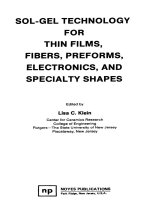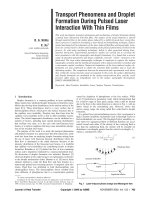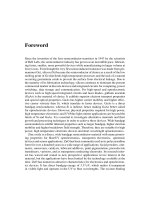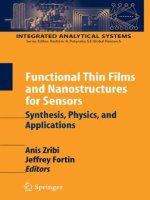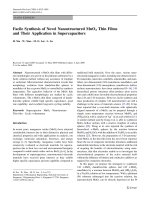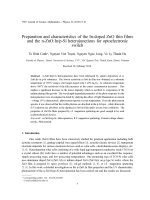High tc superconductor, ferroelectric thin films and microwave devices
Bạn đang xem bản rút gọn của tài liệu. Xem và tải ngay bản đầy đủ của tài liệu tại đây (4.58 MB, 242 trang )
HIGH T
c
SUPERCONDUCTOR, FERROELECTRIC
THIN FILMS AND MICROWAVE DEVICES
TAN CHIN YAW
(B.Sc.(Hons.), NUS)
A THESIS SUBMITTED FOR THE DEGREE OF
DOCTORATE OF PHILOSOPHY
DEPARTMENT OF PHYSICS
NATIONAL UNIVERSITY OF SINGAPORE
2005
ii
ACKNOWLEDGEMENTS
I am very fortunate and thankful to have Prof. Ong Chong Kim as my thesis
supervisor. I am very grateful to him for accepting me into his research centre, Centre
of Superconducting and Magnetic Materials (CSMM), and for allowing me to pursue
my own research ideas while providing the proper guidance. Prof. Ong is truly
concerned for the well-being of his students and works tirelessly to make their
research possible.
I would to thank Dr. Lu Jian, Dr. Chen Linfeng and Dr. Rao Xuesong for their
introduction to microwave theories, the many helpful advices and discussions, and
their friendship.
I would also like to thank Dr. Chen Ping for his introduction on the pulsed laser
deposition technique; Miss Lee Wai Fong for her introduction on photolithography
and wet etching; Dr. Li Jie and Dr. Yan Lei who had helped me with the fabrication of
ferroelectric thin films.
I am also very grateful to Dr. Xu Shengyong and Mr. Li Hongping, who had
pioneered the development of many experimental setups at CSMM; Mr. Tan Choon
Wah and his team of staff at the machine workshop, Department of Physics, who had
help me fabricated many of the items required in my work.
I would also like to thanks my friends at CSMM, who have made my time there
so enjoyable. These people are Mr. Ong Peng Chuan, Mr. Goh Wei Chuan, Miss Liu
Yan, Mr. Liu Huajun and Mr. Wang Peng.
Lastly, I would like to thank my parents for their unfailing love and support.
This work is dedicated to them.
iii
This research was supported in part by DSO National Laboratories
(DSO/C/99100/L) and Defence Science and Technology Agency (MINDEF-NUS-
DIRP/2001/POD0103047).
iv
TABLE OF CONTENTS
ACKNOWLEDGEMENTS ii
TABLE OF CONTENTS iv
SUMMARY ix
LIST OF FIGURES xi
LIST OF SELECTED SYMBOLS AND ABBREVIATIONS xvi
CHAPTER 1: INTRODUCTION TO SUPERCONDUCTORS AND ITS
MICROWAVE APPLICATIONS 1
1.1 Basic characterization parameters of superconductor 2
1.2 Superconductivity at microwave frequencies 3
1.2.1 Meissner effect and London equations 4
1.2.1 Two-fluid model and surface resistance 6
1.3 Microwave applications of superconductor thin film 8
1.4 Structure of HTS thin film microwave devices 10
1.5 YBCO thin film on LaAlO
3
substrate 13
References 18
CHAPTER 2: FABRICATION OF YBCO THIN FILM BY PULSED LASER
DEPOSITION 22
2.1 Pulsed Laser Deposition 22
2.2 Experimental Setup 23
2.2.1 Excimer laser and optics 27
2.2.2 YBCO target 28
2.2.3 Vacuum chamber and vacuum pumping system 28
2.2.4 Silicon radiation heater 29
2.2.5 Temperature control system 31
2.3 YBCO thin film pre-deposition preparation 36
2.3.1 Fused silica laser window cleaning 36
2.3.2 Resurfacing the YBCO target 36
2.3.3 Substrate cleaning 37
v
2.4 Deposition parameters for YBCO thin film 38
References 39
CHAPTER 3: CHARACTERIZATION OF YBCO THIN FILM 40
3.1 X-Ray Diffraction 40
3.1.1 Bragg-Brentano geometry scan 41
3.1.2 Rocking curve measurement 42
3.1.3 XRD measurement setup 42
3.1.4 XRD measurement results 43
3.2 Scanning electron microscopy and atomic force microscopy 47
3.3 Four-wire measurement of dc resistance variation with
temperature 49
3.3.1 Principle of four-wire dc resistance measurement 49
3.3.2 Experimental setup of four-wire resistance measurement 54
3.3.3 Results for the four-wire resistance measurement 57
3.4 Surface resistance measurement 59
3.4.1 Principle of the surface resistance measurement method 59
3.4.2 Structure of the surface resistance measurement probe 61
3.4.3 Results of surface resistance measurement 61
References 65
CHAPTER 4: MICROWAVE RESONATOR AND Q FACTOR 66
4.1 Quality factors of a microwave resonator 67
4.1.1 One-port measurement of Q factor 68
4.1.2 Two-port measurement of Q factor 70
4.2 The importance of high Q factor resonators in microwave
bandpass filter 75
4.3 Factors affecting the Q factor of HTS microstrip resonator 75
4.3.1 Conductor Q factor 76
4.3.2 Dielectric Q factor 78
4.3.3 Radiation and housing Q factor 79
4.4 Half-wavelength microstrip resonator 80
4.5 Miniaturized dual-spiral resonators 81
4.5.1 Geometry analysis of square dual-spiral resonators 82
4.5.2 Optimal compact geometry for s-type dual-spiral 86
vi
4.5.3 Optimal compact geometry for u-type dual-spiral 87
4.6 Comparison of dual-spiral resonators with half-wavelength
resonator 88
References 91
CHAPTER 5: HTS MICROSTRIP CROSS-COUPLED DUAL-SPIRAL
BANDPASS FILTER 92
5.1 Microwave bandpass filter 92
5.1.1 Applications of bandpass filter with high sensitivity and
high selectivity 94
5.1.2 Advantages of HTS microwave bandpass filter 94
5.2 Cross-coupled filter 96
5.2.1 Response of cross-coupled bandpass filter 97
5.3 Cascaded quadruplet filter 98
5.4 Inter-resonator couplings of a dual-spiral resonators 105
5.5 Dual-spiral cross-coupled bandpass filter 113
5.6 Conclusion 117
References 119
CHAPTER 6: FERROELECTRIC THIN FILMS AND MULTILAYERS 121
6.1 Barium strontium titanate ferroelectric thin films 121
6.2 Ba
0.1
Sr
0.9
TiO
3
thin films 124
6.2.1 Preparation of Ba
0.1
Sr
0.9
TiO
3
target 125
6.2.2 Preparation of Ba
0.1
Sr
0.9
TiO
3
thin films 126
6.2.3 Crystallinity of the Ba
0.1
Sr
0.9
TiO
3
thin films 127
6.2.4 Surface morphology of the Ba
0.1
Sr
0.9
TiO
3
thin films 129
6.2.5 Microwave permittivity characterization of Ba
0.1
Sr
0.9
TiO
3
thin films 129
6.3 Epitaxial YBCO/BST/LAO/YBCO thin film multilayer 131
References 136
CHAPTER 7: NONDESTRUCTIVE COMPLEX PERMITTIVITY
CHARACTERIZATION OF FERROELECTRIC THIN FILMS
AT MICROWAVE FREQUENCY 137
7.1 Planar circuit characterization methods for complex permittivity
of ferroelectric thin films at microwave frequencies 137
7.2 Principle of measurement 139
vii
7.3 Determination of dielectric constant 143
7.4 Design and fabrication of the measurement fixture 146
7.5 Results and discussions 148
References 155
CHAPTER 8: TUNABLE HTS/FERROELECTRIC MICROWAVE
RESONATORS AND FILTERS 157
8.1 Introduction 157
8.1.1 Tunable microwave devices 157
8.1.2 Ferroelectric tunable microwave devices 158
8.1.3 Miniaturized tunable HTS/ferroelectric microwave
devices 158
8.2 Design issues of planar ferroelectric microwave devices 159
8.3 Tunable resonator 163
8.4 Fabrication of patterned ferroelectric thin film 164
8.4.1 Fabrication of patterned ferroelectric thin film 173
8.5 Tunable resonator with patterned ferroelectric thin film 177
8.6 Tunable filter 181
References 186
CHAPTER 9: THE FABRICATION AND PACKAGING OF HTS
MICROWAVE DEVICES 188
9.1 Fabrication of HTS microstrip devices 188
9.2 Mask design of HTS microstrip devices 190
9.3 Packaging of HTS microstrip devices 190
9.4 Hermetic sealing 192
9.5 Effect of cavity dimension 193
9.6 Microwave connections 195
9.6.1 Conventional hermetic microwave connection with
microstrip transition 195
9.6.2 Unsuccessful hermetic microwave connection designs 197
9.6.3 Successful hermetic microwave connection designs 197
9.7 Hermetic dc feedthrough 208
References
209
CHAPTER 10: CONCLUSION 210
viii
List of publications by author 212
APPENDIX 1: PROCEDURE FOR PULSED LASER DEPOSITION OF
YBCO THIN FILM 214
APPENDIX 2: PROCEDURE FOR DEPOSITION OF GOLD FILM 217
APPENDIX 3: PROCEDURE FOR PHOTOLITHOGRAPHY AND WET
ETCHING OF SUBSTRATE WITH DOUBLE-SIDED YBCO
THIN FILM
219
APPENDIX 4: PROCEDURE FOR PREPARING INDIUM WIRE SEAL 222
APPENDIX 5: PROCEDURE FOR ASSEMBLING HTS MICROSTRIP
DEVICE IN HOUSING WITH COPPER MICROSTRIP LINE
TRANSITION AND SMA CONNECTOR 223
APPENDIX 6: PROCEDURE FOR ASSEMBLING HTS MICROSTRIP
DEVICE IN HOUSING WITH K CONNECTOR AND
SLIDING CONTACT 225
ix
SUMMARY
This thesis presents a study on the high T
c
superconductor (HTS) YBa
2
Cu
3
O
7-δ
(YBCO) thin films, ferroelectric Ba
0.1
Sr
0.9
TiO
3
thin films and their applications in
passive microwave devices.
YBCO, Ba
0.1
Sr
0.9
TiO
3
and multilayer YBCO/Ba
0.1
Sr
0.9
TiO
3
thin films were
fabricated using the pulsed laser deposition (PLD) technique. The PLD experimental
setup incorporated a silicon radiation heater and a laser beam scanning system for the
fabrication of large-area double-sided YBCO thin films suitable for the production of
microstrip HTS microwave devices. Considerable efforts were spend on the
optimization of the PLD experimental setup and procedures to produce high quality
thin films. The crystalline structure and surface morphology of the thin films were
examined using X-ray diffraction, scanning electron microscopy and atomic force
microscopy. The dc electrical properties of the YBCO thin films were examined using
four-wire measurements and the microwave surface resistance was examined using a
dielectric resonator method. A dual-resonator planar circuit measurement method was
also developed to examine the microwave complex permittivity of the ferroelectric
thin films.
The applications of HTS thin films in the fabrication of high quality factor
microstrip resonators were studied. A novel type of miniaturized microstrip resonator
based on the dual-spiral geometry was developed. The dual-spiral resonators were
found to have quality factors much higher than straight half-wavelength resonator.
The dual-spiral resonators were also found to be highly suitable for the design of
cross-coupled filters, as inter-resonator coupling with suitable phase shift and
coupling coefficient can be easily achieved using the dual-spiral resonator pairs. A
x
highly-compact cascaded quadruplet bandpass filter with enhanced selectivity was
developed using the dual-spiral resonators.
The application of HTS/ferroelectric thin films for planar tunable microwave
devices was studied using YBCO/Ba
0.1
Sr
0.9
TiO
3
multilayer thin films. A process for
the fabrication of patterned ferroelectric was developed. The fabrication process for
patterned ferroelectric thin film enabled the development of tunable planar
HTS/ferroelectric devices with better performance as unnecessary loss and unwanted
tuning were eliminated. Tunable YBCO microstrip resonator and filter with patterned
Ba
0.1
Sr
0.9
TiO
3
thin films fabricated by the process were found to have improved
performance.
As HTS thin film can be easily damaged by improper handling, the fabrication
process of the YBCO thin film microwave devices was carefully designed to avoid
damaging the thin film during the device fabrication process. Packaging designs with
good performance and reliability was also developed for the HTS microstrip devices.
xi
LIST OF FIGURES
Figure Caption Page
1.1 Cross sectional view of the coplanar, microstrip and stripline
transmission lines. 11
1.2 Unit cells of YBa
2
Cu
3
O
6
and YBa
2
Cu
3
O
7
. 14
2.1 Photograph of the plume formed during pulsed laser deposition. 24
2.2 Schematic diagram of the PLD setup used for YBCO thin film
fabrication.
25
2.3 Photograph of the PLD vacuum chamber interior. 26
2.4 Dimension of the silicon heater for substrate with 10 mm height. (a)
Front view. (b) Side view of the heater shown with 5° tilt and loaded
with substrate. 30
2.5
Photograph of the silicon heater loaded with four 10 mm × 10 mm ×
0.5 mm substrates. 32
2.6 Photograph showing the gap between the substrate and the silicon
heater. 33
2.7 Photograph of the homemade K-type thermocouple. 35
3.1
The
2
θ
θ
−
XRD scan of a typical YBCO thin film sample.
44
3.2
Graph of the calculated c-axis lattice parameter against
2
cos /sin
θ
θ
for a typical YBCO thin film sample. 45
3.3 The rocking curve of the (005) peak for a typical YBCO thin film
sample. 46
3.4 The SEM image of a typical YBCO thin film sample deposited with
the optimized deposition parameters. 48
3.5 The SEM image of an YBCO thin film sample deposited with
substrate temperature below 700
°C during PLD.
50
3.6 An AFM image of a typical YBCO thin film sample. 51
3.7 A circuit diagram illustrating the four-wire measurement setup. 53
3.8 The layout of a typical micro-bridge pattern used in four-wire
resistance measurement. 55
3.9 Schematic diagram of the four-wire resistance measurement setup
with temperature variation. 56
3.10 The resistivity versus temperature graph of a typical YBCO thin film
sample. 58
3.11 The schematic diagram of the surface resistance measurement setup. 62
xii
3.12 The transmission S-parameter of the surface resistance measurement
setup loaded with a typical YBCO thin film sample. 64
4.1
The
11
S responses, in Smith chart format, of an under-coupled
resonator, critically-coupled resonator and over-coupled resonator. 69
4.2
The
11
S magnitude response of an under-coupled resonator,
critically-coupled resonator and over-coupled resonator. 71
4.3
The
11
S phase response of an under-coupled resonator and over-
coupled resonator. 72
4.4 (a) A s-type dual-spiral with the two arms wound in the same
direction. (b) A u-type dual-spiral with the two arms wound in the
opposite directions.
83
4.5 The variables used to define a square spiral arm. 84
4.6 The electric current density within the half-wavelength, s-type dual-
spiral and u-type dual-spiral resonators at resonance. All resonators
have 0.2 mm track width. 89
4.7 The scaled layout of 1 GHz s-type dual-spiral, u-type dual-spiral and
half-wavelength resonators. 90
5.1 A graph illustrating the typical parameters used to specify a bandpass
filter. The graph shows the transmission S-parameter response of a
bandpass filter with 1 GHz central frequency, 1 dB insertion loss, 2
dB ripples, 6 % 3 dB bandwidth and 10 % 30 dB rejection
bandwidth. 93
5.2 The transmission S-parameter of four-resonator bandpass filter with
cross-coupled, Butterworth and Chebyshev responses. 99
5.3 Comparison of Chebyshev and cross-coupled responses filters with
different numbers of resonators. 100
5.4 Comparison of 4-resonator cross-coupled responses filters with the
transmission zeros at different frequencies. 101
5.5 Coupling structure of a cascaded quadruplet cross-coupled filter. The
nodes represent the four resonators and the lines represent the
couplings. 102
5.6 Theoretical S-parameter responses of a cascaded quadruplet cross-
coupled filter with central frequency at 1 GHz,
3.5%FBW
=
and 45
dB bandwidth = 6 %. 106
5.7 Example of the transmission S-parameter for (a) positive and (b)
negative inter-resonator couplings. 107
5.8 Examples of dual-spiral resonator pair with positive coupling. 109
5.9 Examples of dual-spiral resonator pair with negative coupling. 110
xiii
5.10 The resonator pair in (a), (b) and (c) are positive even when the
relative position of the two adjacent spirals is different. 111
5.11 An example of the case when all four spirals are in close proximity. 112
5.12 Variation of coupling coefficient, obtained from simulation, with
resonators separation for selected resonator pairs. 114
5.13 Layout of the cross-coupled dual-spiral filter. 115
5.14 Simulated and measured S-parameters responses of the cross-
coupled dual-spiral filter. 116
5.15 Design of the casing for the cross-coupled dual-spiral filter. 118
6.1 A diagram illustrating the simplified crystal structure of the BaTiO
3
unit cell in paraelectric and ferroelectric states. 123
6.2 Top panel: Lattice parameter of Ba
0.1
Sr
0.9
TiO
3
films grown at
different substrate temperatures. Bottom panel: The FHWM of the
(002) XRD peak for Ba
0.1
Sr
0.9
TiO
3
grown at three different
temperatures, with and without annealing at different oxygen
pressures. Inset is the lattice parameters for films grown at 780
°C
and annealed in an oxygen pressure of 25 mbar for 1 to 4 hours. 128
6.3
AFM images of the BST films with scan area of 2
μm × 2 μm. (a),
(b) and (c) are images of films grown at 720, 770 and 790
°C
respectively and annealed
in-situ for 1 hour in 1 bar O
2
. (d), (e) and
(f) are images of films grown at 720, 770 and 790
°C respectively
and annealed in-situ for 1 hour in 0.2 mbar O
2
. 130
6.4 The variation of dielectric constant with temperature for
Ba
0.1
Sr
0.9
TiO
3
thin film grown with substrate temperature at 770 ºC. 132
6.5 The variation of dielectric constant and loss tangent with electric
field for Ba
0.1
Sr
0.9
TiO
3
thin film grown with substrate temperature at
770 ºC. 133
6.6
The
2
θ
θ
−
XRD scan of the YBCO/BST/LAO multilayer thin films.
134
7.1 Schematic diagram of the microstrip dual-resonator measurement
fixture. (a) Top view. (b) Cross sectional view. 140
7.2 Current distribution of the microstrip dual-resonator at (a) the lower
resonant frequency
1
f
and (b) the higher resonant frequency
2
f
.
141
7.3
The simulated
1
f
and
r
ε
curve for 500 nm thick ferroelectric thin
film with air gap of 1.000
μm, 1.025 μm, and 1.050 μm.
145
7.4
The simulated
1
f
and
r
ε
curve for 300 nm, 500 nm, and 1000 nm
thick ferroelectric thin film with air gap of 1.025
μm.
147
7.5 Photograph of the microstrip dual-resonator measurement fixture for
complex permittivity of ferreoelectric thin film. 149
xiv
7.6 The measured variation of dielectric constant with temperature for
Ba
0.5
Sr
0.5
TiO
3
thin film. 150
7.7 The measured electric field dependence of (a) dielectric constant and
(b) loss tangent of Ba
0.5
Sr
0.5
TiO
3
thin film at 30 °C.
152
7.8 Equivalent circuit model of the capacitance between the two pads for
dc bias. 153
8.1 Cross sectional view of tunable microstrip device with the HTS thin
film circuit on a layer of ferroelectric thin film deposited on the
entire face of a substrate. 160
8.2 Possible configurations for providing the dc bias voltage in planar
HTS/ferroelectric tunable microstrip circuits. 162
8.3 Layout and dimension of the tunable resonator. Unit in mm. 165
8.4 The simulated variation of the resonant frequency of the tunable
resonator with dielectric constant for ferroelectric layer with
different thickness. 166
8.5 The simulated variation of the unloaded Q factor of the tunable
resonator with loss tangent for 350 nm thick ferroelectric layer with
different dielectric constant. 167
8.6 The simulated variation of the unloaded Q factor of the tunable
resonator with loss tangent for ferroelectric layer with dielectric
constant of 1250 and different thickness. 168
8.7 The measured variation of resonant frequency and unloaded Q factor
with applied electric field for the inter-digital tunable resonator. 169
8.8 Photographs of an (a) undamaged and (b) electrical discharge
damaged tunable resonator. 170
8.9 (a) Patterned ferroelectric thin film. (b) Ferroelectric thin film on the
entire side of a substrate. 172
8.10 The flowchart of the fabrication process for patterned ferroelectric
thin film. 175
8.11 The SEM images of ferroelectric thin film (a) hill and (b) pit
formations on LAO substrate. 176
8.12 The layout and dimension of the YBCO layer for the tunable
resonator with patterned ferroelectric thin film. 178
8.13 The photograph of the tunable resonator with patterned ferroelectric
thin film. 179
8.14 The measured variation of resonant frequency and unloaded Q factor
with applied electric field for the tunable resonator with patterned
ferroelectric thin film. 180
8.15 Layout of the three-stage HTS tunable filter with patterned
ferroelectric thin film. 183
xv
8.16 The photograph of the tunable HTS filter with patterned ferroelectric
thin film. 184
8.17 The measured (a) transmission and (b) reflection S-parameters of the
tunable filter for different applied voltage. 185
9.1 A hermetic microwave connection for conventional metallic
microstrip circuit. The rf connector socket is secured by screws (not
shown in diagram) to the housing. 196
9.2 The design of a hermetic microwave connection based on housing
with removable bottom cover. 198
9.3 The design of the hermetic microwave connection with copper
microstrip line transition. 199
9.4 The photograph of a transition between gold/HTS microstrip line and
copper microstrip line using resistive welded gold ribbon. The gold
ribbon is 0.254 mm wide, whereas the gold/HTS microstrip line on
the left side is 0.17 mm wide and the copper microstrip line on the
right side is 0.6 mm wide. 201
9.5 The design of a housing with hermetic SMA connection and copper
microstrip line transition. 202
9.6 The photograph of a housing with hermetic SMA connection and
copper microstrip line transition. 203
9.7 The design of a hermetic microwave connection with K connector
and sliding contact. 204
9.8 The design of a housing with hermetic K connector and sliding
contact. 205
9.9 The photograph of a housing with hermetic K connector and sliding
contact. The rf connector sockets had not been installed in this
photograph. 206
9.10 The photograph of a housing with hermetic microwave connection
using K connector and copper microstrip transition line. The dc
connection was based on hermetic SMA connector. 207
xvi
LIST OF SELECTED SYMBOLS AND ABBREVIATIONS
Dielectric constant
ε
r
Permeability
μ
Permeability of vacuum
μ
0
Electrical conductivity
σ
Angular frequency
ω
Atomic Force Microscopy AFM
Magnetic field or magnetic flux density
B
Centre for Superconducting and Magnetic Materials CSMM
direct current dc
Electric field
E
Frequency
f
Resonant frequency f
0
Full-Width at Half-Maximum FWHM
Magnetic field or magnetic field intensity
H
High T
c
Superconductor HTS
Prefix used to indicate an imaginary number
j
Superconducting critical current density
J
c
LaAlO
3
LAO
Pulsed Laser Deposition PLD
Loaded Q factor
Q
l
Unloaded Q factor
Q
u
radio frequency rf
Surface resistance
R
s
Reflection S-parameter S
11
Transmission S-parameter
S
21
Scanning Electron Microscopy SEM
Loss tangent
tan
δ
Superconducting critical transition temperature
T
c
Surface temperature of heater
T
h
X-Ray Diffraction XRD
YBa
2
Cu
3
O
7-δ
YBCO
1
CHAPTER 1:
INTRODUCTION TO SUPERCONDUCTORS AND ITS
MICROWAVE APPLICATIONS
Superconductivity was discovered by Heike Kamerlingh Onnes in 1911. Onnes
was investigating the resistivity of mercury cooled to liquid helium temperature when
it was observed that the resistivity dropped abruptly to zero at a temperature of about
4 K.
In 1933, Walter Meissner and Robert Ochsenfeld discovered that when a
superconductor was cooled to the superconducting state in a magnetic field, the
magnetic field would be expelled from the interior of the superconductor. This
discovery clearly differentiated superconductivity from perfect conductivity.
Since the discovery of superconductivity by Onnes, many other superconducting
metals, alloys and compounds were discovered. Up until 1985, the material with the
highest known critical temperature was a niobium germanium alloy (Nb
3
Ge), which
was discovered in 1973 to have a critical temperature of 23.2 K [1].
In 1986, J. G. Bednorz and K. A. Müller announced the discovery of a
superconducting La-Ba-Cu-O compound with critical temperature of around 35 K [2].
This discovery generated tremendous interests and efforts to discover other
superconductors with higher critical temperature.
In 1987, Paul C. W. Chu and Maw Kuen Wu substituted lanthanum with yttrium
and discovered that YBa
2
Cu
3
O
7-δ
(YBCO) has a critical temperature of around 90 K
[3]. This was a landmark discovery since this critical temperature could be easily
attained using liquid nitrogen which has a boiling point of 77 K. Prior to this
discovery, superconductivity could only be achieved using costly and complex
2
refrigeration techniques or by using liquid helium as the cryogenic refrigerant. Liquid
helium with boiling point of 4.2 K, is rare and expensive, as well as difficult to handle
and store. Unlike liquid helium, liquid nitrogen is a relatively cheap and readily
available cryogenic refrigerant. Furthermore, temperature of around 90 K is relatively
easy to attain and maintain with commercially available closed-cycle cryocooler,
making widespread research and commercial applications of superconductivity
possible.
Many other superconductors with higher critical temperature had since been
discovered. These new superconductors with relatively high critical temperature are
often referred to as High T
c
Superconductor (HTS) while the superconductors
discovered before 1986 are referred as Low T
c
Superconductor (LTS). Although
La
1.85
Ba
0.15
CuO
4
with critical temperature of around 35 K is generally considered to
be the first HTS material, there is no formal temperature definition differentiating
HTS and LTS.
1.1 Basic characterization parameters of superconductor
The temperature at which a material transforms into a superconducting state is
called the critical temperature (
c
T ). The sharp drop of electrical resistance to zero
occurs over a temperature range. A narrower transition temperature range usually
indicates a sample with higher phase purity.
If a superconductor is exposed to sufficiently strong magnetic field, the
superconductor will revert to a non-superconducting state. The minimum field that
will disrupt the superconducting state is called the critical magnetic field (
c
H ).
Superconductors can be classified as type I or type II. A type I superconductor
completely expels magnetic flux from its interior, and completely lose its
3
superconductivity if the applied magnetic field exceeds
c
H . A type II superconductor
has two critical fields:
1c
H , when small localized magnetic flux can exist within its
interior (and partially suppressing the superconductivity) and
2c
H , when it completely
loses its superconductivity. Type I and II superconductors are described in greater
details in section 1.2.1. A superconductor will also lose its superconductivity when it
carries an electrical current with current density exceeding the critical current density
(
c
J ).
Superconductivity is strongly influenced by temperature, magnetic field and
electrical current density.
c
J and
c
H are temperature dependent and will increase
with decreasing temperature.
c
T and
c
J will decrease with increasing applied
magnetic field, while
c
H and
c
T will decrease when a superconductor is carrying
more electrical current.
1.2 Superconductivity at microwave frequencies
In 1957, John Bardeen, Leon Cooper and Robert Schrieffer proposed the first
widely accepted theory on the mechanism of superconductivity, now commonly
referred to as the BCS theory [4]. In this theory, superconductivity is due to phonon
mediated coupling between electron pair with opposite spin, leading to the
superconducting Bose condensation state. The paired electrons, called “Cooper pair”,
can travel without the collisions and interactions present in normal conductor that
leads to resistance. This pairing can only occur when the temperature is lower than
c
T
so that the ordinary thermal induced motions of the electrons are sufficiently reduced.
While BCS theory can explain superconductivity in LTS very well, it cannot
fully explain several features found in HTS. Up till now, there is still no theory that is
4
able to fully explain the superconductivity in HTS satisfactorily. Fortunately, for
passive HTS microwave devices, the phenomenological theory based on the London
equations and the two-fluid theory provide an adequate basic theoretical
understanding and a microscopic theory of superconductivity in HTS materials is not
necessary [5,6].
1.2.1 Meissner effect and London equations
Meissner effect refers to the exclusion of magnetic field within the interior of
superconductors. Meissner effect can be represented using the first London equation:
0
s
t
∂
Λ
−=
∂
J
E , (1.1)
and the second London equation:
0
s
Λ
∇× + =JB . (1.2)
Λ is the London parameter given by
2
s
s
s
m
nq
Λ=
, (1.3)
where
s
m ,
s
n and
s
q are the effective mass, density and electrical charge of the
superconducting carriers respectively.
s
J is the superconducting current density given
by
s
ss s
nq
=
Jv, (1.4)
where
s
v is the velocity of the superconducting carriers. E and B are the electrical
field and magnetic field respectively.
Using equation (1.1) and the Maxwell equations, it can be derived that
5
2
2
1
0
L
λ
∇
−=BB, (1.5)
where
L
λ
is the London penetration depth given by
2
s
L
s
s
m
nq
λ
μμ
Λ
==
’ (1.6)
where
μ
is the permeability. The one-dimension solution of equation (1.5) is
() (0)
L
x
B
xBe
λ
−
= . (1.7)
Equation (1.7) shows that the magnetic field inside a superconductor decreases
exponentially from the surface with a decay length of
L
λ
.
The Meissner effect and London equations are subject to some limitations
because of the relative length scales involved. In BCS theory, the Cooper pair
interacts over a length called the superconducting coherence length, which is given by
F
Bc
ahv
kT
ξ
=
, (1.8)
where
h is the Plank’s constant,
F
v is the electron velocity at the Fermi surface,
B
k is
the Boltzmann’s constant, and
a is a numerical constant of unity order.
The coherence length of a type I superconductor is greater than its London
penetration depth. For type I superconductors, complete exclusion of magnetic flux
occurs for magnetic field H less than
c
H , and superconductivity is destroyed when
c
HH> .
The coherence length of a type II superconductor is about equal to or less than
its London penetration depth. Type II superconductors have two critical magnetic
6
fields,
1c
H and
2c
H . When
1c
HH
<
, type II superconductors will exhibit the
Meissner effect. When
12cc
HHH<< , a type II superconductor will be in the mixed
state, where localized magnetic vortices can penetrate the superconductor without
destroying its superconductivity. When
2c
HH> , the superconducting state is
destroyed.
1.2.2 Two-fluid model and surface resistance
Due to skin effect, the power dissipation of an rf current is larger than dc current.
Surface resistance is used for calculating power dissipation at microwave frequency.
Surface resistance is the real part of surface impedance, which is defined as the ratio
of the tangential electric and magnetic fields ( /
tt
EH) at the surface of the conductor.
Surface impedance can be written as
s
ss
Z
RjX
=
+ , where
s
R
is the surface resistance
and
s
X
is the surface reactance.
The surface impedance of normal conductors can be calculated from their
conductivity (
σ
) using
(1 )
2
s
j
Zj
μ
ωμω
σ
σ
==+
, (1.9)
where
f
π
ω
2= is the angular frequency. For normal conductors,
σ
is a real number
so
2
ss
RX
μ
ω
σ
== . (1.10)
For superconductor at microwave frequency, the conductivity can be derived
from the two-fluid theory [5]. The two-fluid model is based on the concept that there
are two types of conducting current in the superconducting state. They are the
7
superconductive current with carrier density
s
n and the normal current with carrier
density
n
n . The total carrier density is
s
n
nn n
=
+ . The conductivity is given by
2
12
2
1
nn
nL
nq
jj
m
τ
σσ σ
ω
μλ
=− = − , (1.11)
where
τ
is the relaxation time for electron scattering.
At temperatures below
c
T , the variation of
n
n ,
s
n and
L
λ
with temperature (T )
are given by
4
n
c
n
T
nT
⎛⎞
=
⎜⎟
⎝⎠
, (1.12)
4
1
s
c
n
T
nT
⎛⎞
=−
⎜⎟
⎝⎠
, (1.13)
and
1
4
2
() (0)1
LL
c
T
T
T
λλ
−
⎡
⎤
⎛⎞
=−
⎢
⎥
⎜⎟
⎢
⎥
⎝⎠
⎣
⎦
, (1.14)
where
2
(0)
s
L
s
s
m
nq
λ
μ
=
.
In the limit of local electrodynamics (
L
ξ
λ
<
< ), which holds true for almost all
the HTS materials, the surface impedance can be calculated from the complex
electrical conductivity using
12
()
0
s
jω
Z
σ jσ
μ
ω
=
−
. (1.15)
8
Assuming
21
σ
σ
<< , which is a good approximation for temperature lower than
and not too close to
c
T , the surface resistance and surface reactance can be
approximated using
22 3
1
1
2
s
L
R σ
μ
ωλ
= , (1.16)
and
()
s
L
X
ω
μωλ
=
. (1.17)
As the microwave power dissipated by a superconductor can be calculated from
s
R
using [6]
2
1
2
st
surface
PR ds=
∫
H , (1.18)
it is essential that
s
R
be small for microwave devices to have low loss.
1.3 Microwave applications of superconductor thin film
Superconducting microwave devices can be broadly divided into three
categories based on the superconductive property it exploited: those based on the
transition between the superconducting state and the normal state, those based on
Josephson junction and those based on the extremely low surface resistance of the
superconducting state.
The transition between the superconducting state and the normal state can be
used for fabricating microwave devices such as switch [7-9], tunable attenuator [10]
or limiter [11]. A superconducting switch is used to control the transmission of
microwave signal and is usually integrated into part of a microwave circuit. The
switch is activated by the application of a control signal in the form of temperature,
9
magnetic field or dc electrical current change, such that the switch ceases to be
superconductive and stops the transmission of the microwave signal. A tunable
attenuator works similarly except that control signal is only sufficient to attenuate the
transmitted power. A limiter is also similar except the microwave signal is used as the
control signal. A limiter can be used to protect power sensitive microwave component
from overload.
In 1962, B. D. Josephson proposed that a junction formed by two weakly
connected superconductors can allow the nonlinear superconducting quantum
tunneling of Cooper pairs [12]. This phenomenon was confirmed experimentally by P.
W. Anderson and J. M. Rowell in 1964 [13]. Such junction structures are now called
Josephson junction. Josephson junction can be used in microwave devices such as rf
detectors and mixers [14-20], rf generators and oscillators [21-24], amplifiers [25-28]
and phase shifters [29,30]. Jospehson junction based microwave devices have the
potentials of been extremely low noise, very low power consumption and the ability to
perform up to very high frequency.
The third category of superconducting microwave devices exploit the very low
surface resistance of superconductors. Passive microwave devices can benefit from
the very low surface resistance of superconductors in two ways. One way is directly
from the reduced microwave dissipation which means lower insertion loss or higher Q
factor. The other way is from the miniaturization of microwave devices without
significant performance degradation. While almost all passive microwave components
can benefit from reduced microwave dissipation, the advantage of superconductor is
most apparent in devices such as delay lines, resonators, and filters where low loss is
critical.

